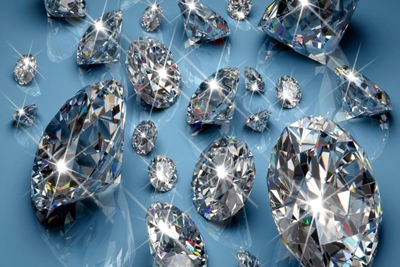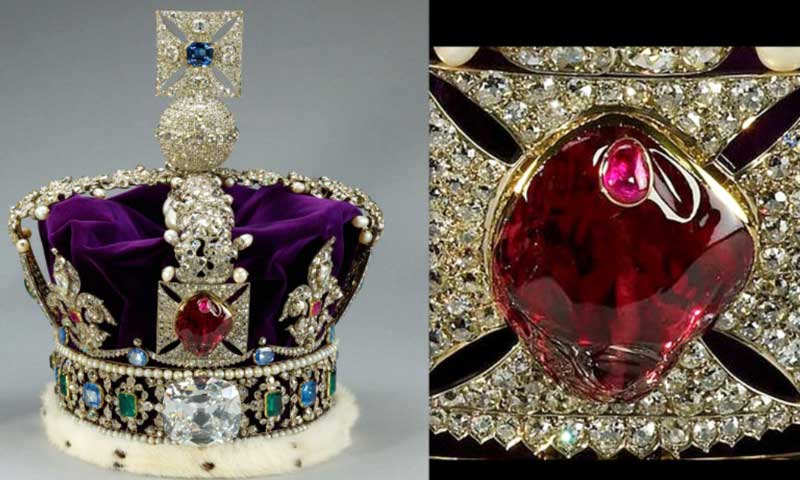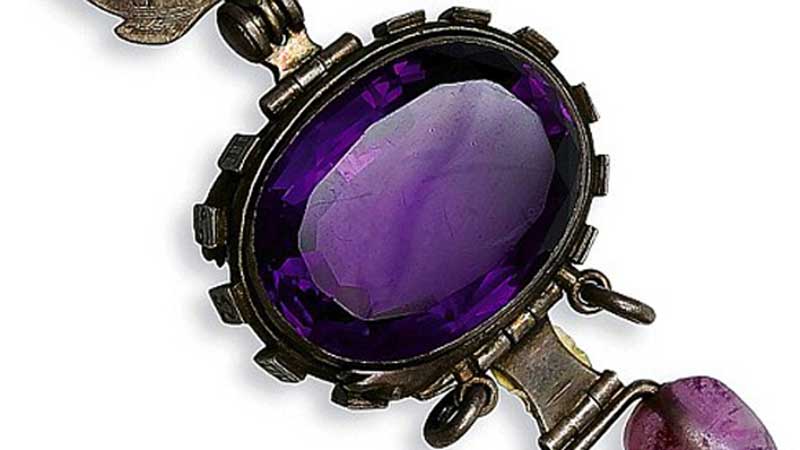
It is said and believed by many that, there are certain gems which not only glitter and gleam, but they also have some unknown power to bring misfortune, sorrow and even death. They are infamous and mysteriously haunted jewels. There is the possibility that myths were deliberately created to increase the reputation of those gems to increase their demand and value. But, the mythical stories aided in adding more mystery to those gems, even they are not pleasant. The stories ultimately make them spectacularly lethal.

The story of the ‘Hope Diamond’ starts with the French merchant traveler Jean-Baptiste Tavernier, who bought the brilliant blue stone in India, probably before 1668. The story says that, he was torn to pieces by wild dogs in Constantinople. It is said that Tavernier sold the 45.52 carat diamond, mined in India in the 17th century, to King Louis XVI, who had the stone re-cut and set in gold by the court jeweler and gifted it to his beloved wife Marie Antoinette. Marie Antoinette was tried by the Revolutionary Tribunal and was guillotined on 16 October 1793. After that, the ‘French Blue’, as it was known, disappeared into history. It is believed that somehow the stone was acquired by King George IV of England, but it was sold after his death to repay his enormous debts. After that the gemstone changed hands many times and was purchased by a London based gem collector and banker Henry Philip Hope and came to be known as the ‘Hope Diamond’. However, the Hope Family was also forced to sell the stone to pay off their debts and it was bought by New York based Joseph Frankels & Sons, who also were constrained to sell it to cover debts. In 1909, Pierre Cartier bought the Hope Diamond and sold it to the Washington, DC socialite and heiress Evalyn Walsh McLean. However, the gem did not spare the McLean family either. While in possession of the diamond, her son died in a car accident, her daughter died of a drug overdose and her husband left her for another woman and finally died in a sanitarium from brain atrophy due to alcoholism. Even, she was forced to sell their newspaper, the Washington Post and went bankrupt. After the death of McLean from pneumonia in 1947, Harry Winston Inc. purchased her entire jewelry collection and in 1958, they donated the iconic Hope Diamond, which was worth a quarter of a billion dollars at that time, to the Smithsonian Institution National Museum of Natural History in Washington, DC, where it resides on display to this day.

The huge 105.6-carat Koh - i- Noor diamond is believed to have been extracted from the Kollur mine in Golconda, India. The Persian term Koh-i-Noor means ‘mountain of light’. The name of the gem first appeared in ‘Babarnama’, the memoirs of Zahiruddin Muhammad Babur, the founder of the Mughal Empire in India, where he mentioned that, the magnificent diamond was stolen from the Rajah of Malwa in 1306, and it was a whopping 739 carats in its original. Shah Jahan, a subsequent Mughal emperor, who built the wonderful Taj Mahal, incorporated the stone into his Peacock Throne, but he was imprisoned by his son Aurangzeb in thr Agra Fort for the rest of his life.
It is said that, once the gemstone served as the third eye of an idol of a Hindu goddess. According to Hindu myths, he who owns the Koh-i-Noor would own the world, but would also know all its misfortunes and only God or woman can wear it with impunity.
After the fall of the Mughal Empire, The exotic diamond traded hands among various Hindu, Mongolian, Persian, Afghan and Sikh rulers, leaving a trail of blood behind it. Those unfortunate owners are known to have been clubbed to death, stabbed, poisoned, mutilated and even blinded with hot needles.
According to Historical records, the diamond was acquired by the British in 1849 and given to Queen Victoria in 1850. Since then it has only been worn by women of the royal family, including the late Queen Elizabeth, wife of King George VI. Currently, it is set as one of the jewels within a British monarchy crown that is kept safely behind glass, at the Tower of London Jewel House.

A big deep red ruby, set in the middle of England’s Imperial State Crown, is known as Black Prince’s Ruby. However, it is not a ruby at all, but a large spinel, a red glassy mineral worth much less than a ruby, hence it is also mentioned as ‘the great imposter’.
It is believed by many that the so called ruby was mined from Badakshan, which is present day Tajikistan and is traced back to the 14th century, when it was plundered by Don Pedro the Cruel, the ruler of Seville in Spain, from the corpse of the Prince of Granada, Abū Sa’īd, who was stabbed by Don Pedro or his men. Within a short time of the incidence, Don Pedro appealed to the Black Prince, the son of Edward III of England, as his illegitimate brother led a revolt against him. After the revolt was successfully doused, the Black Prince demanded the ruby as his reward for the help he rendered and it is assumed that the Black Prince took the Ruby back to England. After that, it was absent from the historical records until 1415. It is said that, around the same time, Edward contracted a mysterious disease, which caused his death nine years later.
After that, the Black Prince’s Ruby mysteriously disappeared from the pages of history till 25 October 1415, when in the Battle of Agincourt, Henry V of England was seen with a helmet adorned with jewels, including the Black Prince’s Ruby. In the battle, the French Duke of Alencon struck him on the head with an axe and Henry nearly lost the helmet and his life. At the end, Henry won the battle and the Black Prince's Ruby was saved. It is said that, Richard III also had the jewel in his helmet, when he was killed in the Battle of Bosworth, the last significant battle of the Wars of the Roses.

In 1521, a great pinkish-red ruby was mentioned in the inventory of Henry VIII, which is possibly the Black Prince’s Ruby. It remained there till the time of Oliver Cromwell, who was one of the signatories of King Charles I’s death warrant in 1649 and seized all the principal symbols of the king's power, including the bejeweled helmet, disassembled the ruby and sold it. What happened to the Black Prince’s Ruby is unknown, but Cromwell's body was exhumed on 30 January 1661. After that, his body was hanged in chains, thrown into a pit, his head was cut off and displayed on a pole outside the Westminster Hall until 1685.
When the monarchy was restored in 1660, the jeweler who bought the Black Prince’s Ruby sold it back to Charles II. However, it was nearly lost again, when the infamous Irish colonel Thomas Blood attempted to steal the crown jewels of England from the Tower of London in 1671. At her coronation in 1838, Queen Victoria was crowned with a new Imperial State Crown specially made for the occasion adorned with 3093 gems, including the Black Prince’s Ruby at the front.
In 1841, the crown was almost consumed by fire. As the Tower of London was on fire, police inspector Pierse broke through the iron bars with a crowbar and rescued it, along with other irreplaceable objects. During World War II, the royal regalia were once more in danger from Hitler's bombers. However, they survived undamaged and today the giant Black Prince's Ruby with all its glory is safely housed in the Tower of London, along with the rest of the English Crown Jewels.

The Black Orlov, a gorgeous 67.50 carat, cushion-cut diamond, was unearthed in India during the early 19 th century. Also known as the ‘Eye of Brahma Diamond’, it supposedly featured as one of the eyes of a statue of the Hindu god of creation, Brahma in a temple of Pondicherry. The gem was apparently stolen by a Jesuit monk and according to the myth, the theft caused the diamond to become cursed.
A diamond dealer J. W. Paris is said to have taken the diamond to the United States in 1932 and within a short time he committed suicide by jumping from a skyscraper in New York City. According to ‘The Nature of Diamonds’, a Cambridge University Press publication in 1998, the diamond was subsequently acquired by two Russian Princesses Leonila Galitsine-Bariatinsky and Nadia Vygin-Orlov, after whom the diamond was named. Unfortunately, both of them committed suicide months apart, by jumping to their deaths from buildings in Rome.
In 1947, Charles F Winson bought the diamond and in an attempt to break the so called curse, he cut it to its current size, placed it in a setting surrounded by 108 diamonds and attached it on a necklace of 124 diamonds.
Since then, the Black Orlov has been purchased and resold by a succession of private owners, and has been displayed at several museums, including London's Natural History Museum and the American Museum of Natural History in New York City, USA.

The Delhi Purple sapphire, also said to be a cursed gem, is another imposter. In fact, it is not really a sapphire, it is an amethyst, a type of violet-hued quartz.
It is said that, during the Indian Mutiny of 1857, the mysterious gemstone was plundered by a British Cavalryman Colonel W. Ferris from a Hindu temple, dedicated to Lord Indra, the god of war and weather. As soon as he returned to England, Ferris began to suffer a series of financial misfortunes and his family was on the brink of collapse. As if that was not enough, members of the family also started to suffer a series of debilitating illnesses. He took it as the curse of the gem that he bought from India. His apprehension was confirmed when he gave the stone to a friend of the family who inexplicably committed suicide.
In 1890, Heron-Allen, a reputed polymath, writer and scientist, agreed to accept the stone in 1890 from Ferris’ beleaguered son. He was a rational man and was certainly not a man who would be influenced by superstitions.
However, within a short time, Heron-Allen lost his reasoning and began to attribute a series of unfortunate events to the curse of the stone. In a desperate attempt to neutralize the curse Heron-Allen had it bound with a silver ring fashioned as a double headed snake. He had the ring inscribed with the symbols of the Zodiac and also attached two amethyst scarab beetles to it. Probably, that kept the stone quiet for a couple of years and in 1902, he reluctantly lent the Delhi Sapphire to a friend. But, as the friend was beset by a series of unlucky events, he immediately returned it to Heron-Allen. This made Heron-Allen disgusted of the stone and in frustration he threw it into the Regent’s Canal. As luck would have it, the ring adorned with the gem was dredged from the canal and taken to a local jeweler. The jeweler recognised the stone as the one he had mounted on the ring and honestly returned the ring to Heron-Allen. After the incident, one of his friends asked him to borrow the jewel and Heron-Allen unwillingly lent it out again. This time the unfortunate recipient was a professional singer who could never sing again after wearing the cursed gem, as she lost her voice.
This was more than enough for Heron-Allen and he packed the Delhi Sapphire into seven boxes filled with charms and deposited it in the safe custody of his bank with instructions that it should not to be opened until 33 years after his death. Heron-Allen died in 1944 and after his death, his daughter did not wait that long to dispose of the cursed gem and quickly donated the amethyst to London's Natural History Museum in 1943. Along with the stone, she also gave them a letter that her father wrote cautioning future owners against directly handling it. The mysterious Delhi Purple sapphire is now permanently on display as an exhibit in the Natural History Museum's Vault Collection of precious gemstones.
